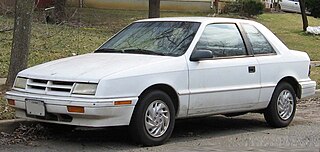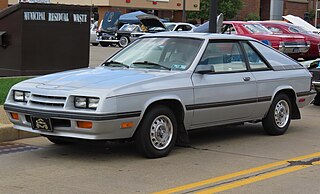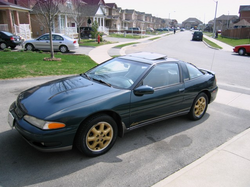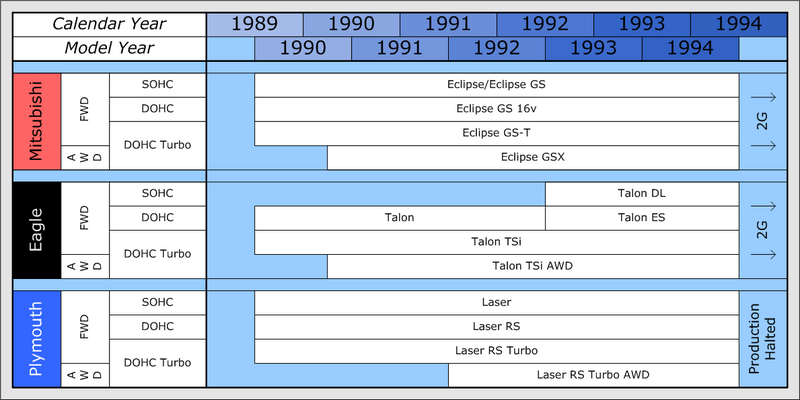
Eagle was a brand of the Chrysler Corporation following the purchase of American Motors Corporation (AMC) in 1987 and marketed through the end of the 1998 model year. It was aimed at the enthusiast driver and promoted as more "European" than the automaker's similar models.

The Eagle Talon is a two-door 2+2, front-wheel drive (FWD) or all-wheel drive (AWD) hatchback coupé manufactured and marketed from 1989 until 1998 and sold by Eagle along with rebadged variants the Plymouth Laser and Mitsubishi Eclipse.

The Mitsubishi Eclipse is a sport compact car that was produced by Mitsubishi in four generations from 1989 until 2011. A convertible body style was added during the 1996 model year.

The Mitsubishi 3000GT is a front-engine, all-wheel/front-wheel drive grand touring/sports car manufactured and marketed by Mitsubishi from 1990 until 2000 over three different generations. Manufactured in a three-door hatchback coupé body style in Nagoya, Japan, the 2+2 four-seaters were marketed in the Japanese domestic market (JDM) as the GTO, and globally as 3000GT. In North America, it was sold both as the Mitsubishi 3000GT (1991–1999) and the Dodge Stealth (1991–1996), a badge engineered, mechanically identical captive import. As a collaborative effort between Chrysler and Mitsubishi Motors, Chrysler was responsible for the Stealth's exterior styling.

The Dodge Daytona is an automobile which was produced by the Chrysler Corporation under their Dodge division from 1984 until 1993. It was a front-wheel drive hatchback based on the Chrysler G platform, which was derived from the Chrysler K platform. The Chrysler Laser was an upscale rebadged version of the Daytona. The Daytona was restyled for 1987, and again for 1992. It replaced the Mitsubishi Galant-based Challenger, and slotted between the Charger and the Conquest. The Daytona was replaced by the 1995 Dodge Avenger, which was built by Mitsubishi Motors. The Daytona derives its name mainly from the Dodge Charger Daytona, which itself was named after the Daytona 500 race in Daytona Beach, Florida.

The Mitsubishi Galant is an automobile which was produced by Japanese manufacturer Mitsubishi from 1969 until 2012. The model name was derived from the French word galant, meaning "chivalrous". There have been nine distinct generations with total cumulative sales exceeding five million units. It began as a compact sedan, but over the course of its life evolved into a mid-size car. Initial production was based in Japan, but from 1994 the American market was served by vehicles assembled at the former Diamond-Star Motors (DSM) facility in Normal, Illinois.

The Dodge Spirit is a mid-size 5- or 6-passenger sedan that was introduced in January 1989 as a replacement for the similarly sized Dodge 600. The Spirit was Dodge's version of the Chrysler AA platform, a stretched variation of the Chrysler K platform. It was assembled at Newark Assembly in Newark, Delaware, Toluca Car Assembly in Toluca, Mexico, as well as Valencia, Venezuela, and shared its basic design with the 1990 to 1994 Chrysler LeBaron sedan, the 1989 to 1995 Plymouth Acclaim, and the export-only 1989 to 1995 Chrysler Saratoga.

The Dodge Shadow and Plymouth Sundance are economical 3-door and 5-door hatchbacks that were introduced for the 1987 model year by the Chrysler Corporation. For 1991, a 2-door convertible variant was added to the Shadow lineup; this bodystyle was not offered by Plymouth. The Sundance/Shadow replaced the Omni/Horizon models of their respective marque.

The Eagle Summit is a line of subcompact cars produced for two generations by Mitsubishi and sold by Eagle from 1989 until 1996. It was marketed as a captive import by the Jeep-Eagle sales division that was established after Chrysler Corporation purchased American Motors Corporation (AMC) in 1987.

The Dodge Colt is a subcompact car that was manufactured by Mitsubishi Motors and marketed by Dodge for model years 1971 to 1994 as captive imports. Rebadged variants include the Plymouth Champ and Plymouth Colt, both were marketed by Plymouth.

Plymouth Voyager is a nameplate for a range of vans that were marketed by the Plymouth division of Chrysler. From 1974 until 1983, the Voyager was a full-size van, sold as the counterpart of Dodge Sportsman. For 1984, the Voyager became a Chrysler minivan sold alongside the Dodge Caravan; as a minivan, three generations of the Voyager were sold from 1984 until 2000. Following the closure of the Plymouth division in 2000, the Voyager was marketed under the Chrysler brand, where it was sold through 2003.

The Dodge Stratus is a mid-size car that was introduced by Dodge in December 1994 and was based on the 4-door sedan Chrysler JA platform. The Stratus, Plymouth Breeze, and Chrysler Cirrus were all on Car and Driver magazine's Ten Best list for 1996 and 1997. It received critical acclaim at launch, but ratings fell over time. An updated version of the Stratus was introduced for 2001, with the Cirrus being renamed as the Chrysler Sebring, and a coupé model was also added to the range. Production ended in early 2006 at the Sterling Heights Assembly Plant after building 1,308,123 Stratus and Sebrings since 2000.

The Chrysler Sebring is a line of mid-size automobiles that was sold from 1995 through 2010 by Chrysler. Three generations of convertibles, two generations of sedans, and two generations of coupes were produced. Although the coupe shared the same name and some styling cues, it was mechanically unrelated to the other Sebring models.

The Mitsubishi Sirius or 4G6/4D6 engine is the name of one of Mitsubishi Motors' four series of inline-four automobile engines, along with Astron, Orion, and Saturn.

The Mitsubishi Chariot is an automobile manufactured and marketed by Mitsubishi from 1983 to 2003. It is a small multi-purpose vehicle (MPV). Based on the SSW concept car first exhibited at the 23rd Tokyo Motor Show in 1979, the MPV derives its nameplate from chariots used by the ancient Greek and Roman empires.

The Plymouth Acclaim is a mid-size sedan produced in the 1989 to 1995 model years. The Acclaim was Plymouth's updated replacement for both the similarly sized E-body Caravelle and the K-body Reliant. Badge engineering was employed to give Dodge and Chrysler their own versions of the AA-body Acclaim: the Dodge Spirit, the Chrysler LeBaron sedan, and the export-market Chrysler Saratoga. It was replaced by the Plymouth Breeze in 1996.

The Dodge Charger (L-body) was a subcompact 3-door hatchback/fastback built by Dodge from 1981 to 1987, and based on Chrysler's front-wheel drive L platform. A companion model, the Plymouth Turismo, was also marketed.

The first generation Subaru Legacy is a mid-size family car / wagon developed by Fuji Heavy Industries. The Legacy was an all new model, and was considered a notable departure from Subaru products in the past.

The first-generation Chrysler minivans are a series of minivans produced and marketed by the Chrysler Corporation from the 1984 to the 1990 model years. Introduced as the first minivans from an American-brand manufacturer and popularizing the minivan as a vehicle, the Dodge Caravan and Plymouth Voyager were launched ahead of chief competitors Chevrolet Astro/GMC Safari and Ford Aerostar.

The RS-platform Chrysler minivans are a short- and long-wheelbase passenger minivans marketed by Chrysler from model years 2001–2007, as the fourth generation Chrysler minivans, heavily revised versions of their predecessors, the NS minivans.























